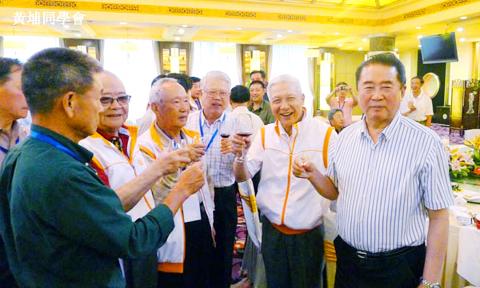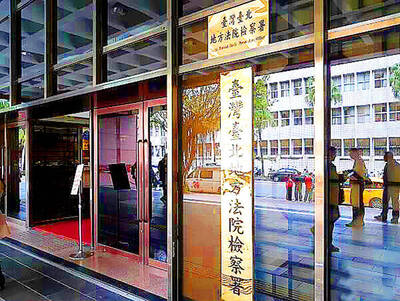Lawmakers across party lines yesterday lashed out at a retired general for allegedly suggesting that the Republic of China (ROC) Army and the People’s Liberation Army (PLA) be called “China’s army.”
Taiwanese media, citing a Chinese media report quoting PLA Major General Luo Yuan (羅援), said a Taiwanese speaker recently told a gathering of retired generals from both sides of the Strait in China: “From now on, we should no longer separate the ROC Army and the PLA. We are all China’s army.”
The report identified the speaker as former ROC Air Force General Hsia Ying-chou (夏瀛洲).

Photo: Lo Tien-pin, Taipei Times
The Ministry of National Defense (MND) yesterday issued a statement saying it had checked with Hsia, who said the media report was “not factual.”
The statement said the ministry had never authorized any group or individual to discuss, exchange views or speak with China on its behalf, adding that any comments made by individuals were said in a “private” capacity.
DENIAL
Hsia’s denial did little to appease lawmakers, with the Chinese Nationalist Party (KMT) caucus demanding the resignation of Minister of National Defense Kao Hua-chu (高華柱) and Political Warfare Department Acting Director General Wang Ming-wo (王明我), saying they had “failed to set clear rules on military personnel exchanges with China.”
KMT caucus whip Hsieh Kuo--liang (謝國樑) said the reported comments had “seriously damaged the country’s dignity.”
Although retired generals are not banned from visiting China, the ministry must ensure that their statements and actions in China “meet public expectations,” Kao said.
KMT Legislator Wu Yu-sheng (吳育昇) said Hsia should apologize to the public and the Taiwanese military if the reports were true.
Wu added that statutory rules were needed to ban retired military officers from engaging or attending military-related exchanges or forums in China.
Wang, however, expressed reservations about formally banning cross-strait exchanges of military officers.
“The MND never authorizes any groups to attend these exchange activities,” Wang said.
He added that under current rules, retired military officers are not barred from making statements or attending cross-strait military exchange activities and are not subject to punishment as long as they do not disclose classified information.
Dissatisfied with Wang’s answer, Hsieh said the ministry, including Kao, should be held responsible if it failed to address the problem.
Democratic Progressive Party (DPP) lawmakers questioned whether Hsia should continue receiving pension benefits as mandated by law, which amounts to about NT$170,000 a month.
If the allegations were true, the government should consider whether it is right that the retired general, “a person who wants to be a part of the Chinese army,” deserves to continue receiving money from Taiwanese taxpayers, DPP Legislator Wong Chin-chu (翁金珠) said.
‘TRAITORS’
DPP Legislator Tsai Huang--liang (蔡煌瑯) said retired generals who had traveled to China are “traitors who wished they were communists.”
The DPP caucus said the caucus was also considering amending the law to prevent retired senior officers from imitating the behavior of those retired generals, which they said had “impacted on Taiwan’s security.”
Replying to media questions on the sidelines of an industrial forum in Taipei, Premier Wu Den-yih (吳敦義) said he found Hsia’s alleged remarks unacceptable, adding that they “were inconsistent with the fundamental policy of the Republic of China.”

INVESTIGATION: The case is the latest instance of a DPP figure being implicated in an espionage network accused of allegedly leaking information to Chinese intelligence Democratic Progressive Party (DPP) member Ho Jen-chieh (何仁傑) was detained and held incommunicado yesterday on suspicion of spying for China during his tenure as assistant to then-minister of foreign affairs Joseph Wu (吳釗燮). The Taipei District Prosecutors’ Office said Ho was implicated during its investigation into alleged spying activities by former Presidential Office consultant Wu Shang-yu (吳尚雨). Prosecutors said there is reason to believe Ho breached the National Security Act (國家安全法) by leaking classified Ministry of Foreign Affairs information to Chinese intelligence. Following interrogation, prosecutors petitioned the Taipei District Court to detain Ho, citing concerns over potential collusion or tampering of evidence. The

‘FORM OF PROTEST’: The German Institute Taipei said it was ‘shocked’ to see Nazi symbolism used in connection with political aims as it condemned the incident Sung Chien-liang (宋建樑), who led efforts to recall Democratic Progressive Party (DPP) Legislator Lee Kun-cheng (李坤城), was released on bail of NT$80,000 yesterday amid an outcry over a Nazi armband he wore to questioning the night before. Sung arrived at the New Taipei City District Prosecutors’ Office for questioning in a recall petition forgery case on Tuesday night wearing a red armband bearing a swastika, carrying a copy of Adolf Hitler’s Mein Kampf and giving a Nazi salute. Sung left the building at 1:15am without the armband and apparently covering the book with a coat. This is a serious international scandal and Chinese

Seventy percent of middle and elementary schools now conduct English classes entirely in English, the Ministry of Education said, as it encourages schools nationwide to adopt this practice Minister of Education (MOE) Cheng Ying-yao (鄭英耀) is scheduled to present a report on the government’s bilingual education policy to the Legislative Yuan’s Education and Culture Committee today. The report would outline strategies aimed at expanding access to education, reducing regional disparities and improving talent cultivation. Implementation of bilingual education policies has varied across local governments, occasionally drawing public criticism. For example, some schools have required teachers of non-English subjects to pass English proficiency

TRADE: The premier pledged safeguards on ‘Made in Taiwan’ labeling, anti-dumping measures and stricter export controls to strengthen its position in trade talks Products labeled “made in Taiwan” must be genuinely made in Taiwan, Premier Cho Jung-tai (卓榮泰) said yesterday, vowing to enforce strict safeguards against “origin laundering” and initiate anti-dumping investigations to prevent China dumping its products in Taiwan. Cho made the remarks in a discussion session with representatives from industries in Kaohsiung. In response to the US government’s recent announcement of “reciprocal” tariffs on its trading partners, President William Lai (賴清德) and Cho last week began a series of consultations with industry leaders nationwide to gather feedback and address concerns. Taiwanese and US officials held a videoconference on Friday evening to discuss the